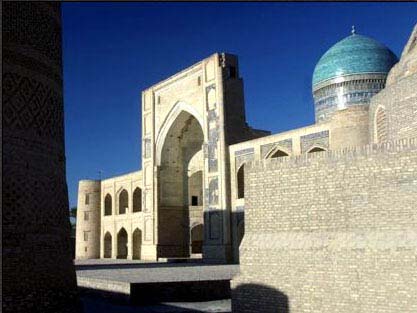The Mir-i-Arab madrasa (1535) across the plaza forms,
with the mosque, Bukhara's main kosh ensemble. One of only two working
madrasas allowed in the Soviet Union (the other was in Tashkent), it has
never closed to students and never opened to tourists -who can glimpse
from outside the calligraphy and mosaic round the drums supporting its  two
blue domes, but still miss out on some of the finest ceramic decoration
in Bukhara. Its 120-130 students study Islamic law and literature and Arabic
for five to seven years, and live in two storeys of cells with balconies
round the central courtyard. Their main assembly hall is under the dome
to the right of the pishtak, Under the left dome are buried Ubaydullah
Khan (one of the first Bukharan royals not to have his own mausoleum) and
Sheikh Mir-i-Arab after whom the madrasa is named. He is variously described
as an architect, a Yemeni merchant, and 'spiritual mentor of the early
Sheibanids'. He may have been all three. He certainly seems to have been
foreign, to have founded the madrasa and to have paid for it with money
made by Ubaydullah from the sale of 3000 Persian slaves, or Shi'ites branded
slaves for belonging to the wrong Muslim sect in a Sunni city. two
blue domes, but still miss out on some of the finest ceramic decoration
in Bukhara. Its 120-130 students study Islamic law and literature and Arabic
for five to seven years, and live in two storeys of cells with balconies
round the central courtyard. Their main assembly hall is under the dome
to the right of the pishtak, Under the left dome are buried Ubaydullah
Khan (one of the first Bukharan royals not to have his own mausoleum) and
Sheikh Mir-i-Arab after whom the madrasa is named. He is variously described
as an architect, a Yemeni merchant, and 'spiritual mentor of the early
Sheibanids'. He may have been all three. He certainly seems to have been
foreign, to have founded the madrasa and to have paid for it with money
made by Ubaydullah from the sale of 3000 Persian slaves, or Shi'ites branded
slaves for belonging to the wrong Muslim sect in a Sunni city.
Next to and south of the madrasa, the Amir Alim Khan madrasa
was built near the start of the 19th century. With separate courtyards
for living and working it breaks all the architectural rules for madrasas
and was always more important as a library, which it still is, though now
for children.
[back]
|

